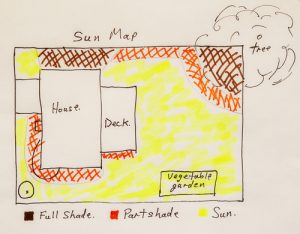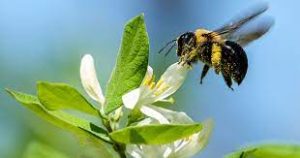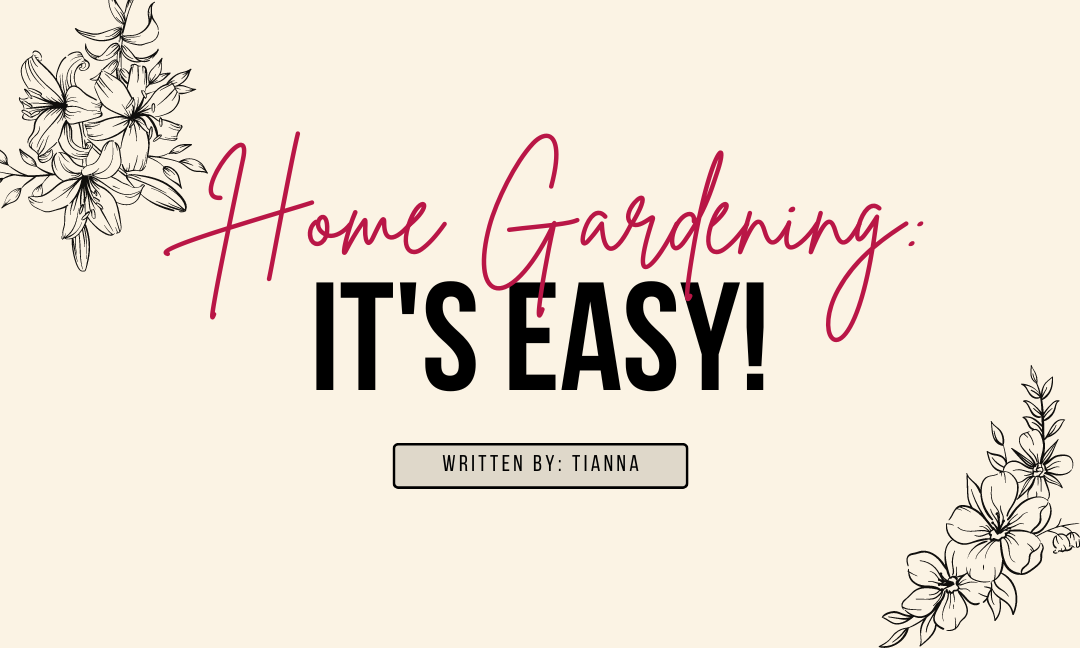Written By: Tianna
Edited By: Niyati Patel
Designed By: Cece Ndiwa
Published By: Maryam Khan
The Beginners Guide to Home Gardening

DiedovStock – stock.adobe.com
Spring is right around the corner, and that means it’s time to think about your garden!
Gardening is something that a lot of people try to do and it can be frustrating, long, and sometimes seemingly fruitless. That won’t be the case this year! In just a few paragraphs I will give you the ultimate beginners guide to gardening.
How to Start Home Gardening
Oftentimes, people will go to their local plant nursery and buy a pack of seeds, slap them in some soil, and hope for the best. This could work at times, but before we get our hands dirty we need to learn about what makes a good garden.
Start by making a sun map. This will be a birds eye view of the area you wish your plants to go. Whether that be your front or backyard, your balcony, or even your kitchen.
After the general room layout has been completed it is time to sketch the sun patterns. You can do this one of two ways. The first way is watching the sun in the morning, midday, and in the evening and seeing where the shadows are most prominent and what areas get the most sun. Alternatively, you can predict this by knowing where the sun rises and sets in relation to your gardening area.
Remember: the sun rises in the east and sets in the west.
Sketch the way the sun shines for morning, midday, and evening on the same map using different colours for each time. Having a sun map will allow for easier prediction on where your plants will thrive. It is also helpful to note where the wind would be the strongest, and where wind protected areas are located.
Did you know that full sun means the area gets more than 6 hours of sunlight per day?

Above is an example of one way you could make your sun map. It does not have to be anything fancy, just a visual way to see how the sun interacts with your gardening space.
After you have sketched out your sun map, it may be best to create a planting journal. This allows you to record what you want to plant, where, and when. By doing this you can record your plant’s journey throughout the growing season and make any necessary changes the next year. Perhaps, the peppers you planted should’ve been moved to the other side of the yard, or your tomatoes didn’t get watered enough. No matter what it could be, by having a planting journal you can always refer back to what worked and some things that simply did not.
Finally, test your soil. Some soil is more acidic than others and you want to make sure that your plants are getting the best nutrients possible. When your plants get the best treatment, that means you do too! You want to make sure there won’t be any bad chemicals being ingested after labouring over your veggies. A neutral pH is best for plants, meaning that the pH is between 6.5 and 7.5. You can buy soil testers at your local gardening centre.
Time to Garden!
This is where the exciting part happens, the gardening! You can start your garden by seeds or by purchasing plants that are already growing. Either way this is where your journey really begins. When you pick your plant, you want to make sure that you can provide everything it needs. Whether that be full sun, partial sun, full shade, wind protection, or certain nutrients. By doing some research on what plant works best for your gardening space, you will have better results when it comes time for harvest.

Many of the best plants for beginners can be grown outside, or for those who do not have a backyard they can even be grown indoors with the proper provision of light!
For those who do not have an outdoor space:
- Chillies
- Basil
- Coriander
- Perennial herbs
- Mint
- Thyme
- Rosemary
- Chives
- Microgreens
- Bean sprouts
For those who do have an outdoor space:
- Zucchini
- Peppers
- Radishes
- Green beans
- Tomatoes
- Potatoes
- Strawberries
- Lettuce
- Spinach
- Basil
- Turnips
- Cucumbers
- Carrots
- Eggplant
Why Grow Your Own Produce?

Although it may be easier to pop on over to your local grocery store and purchase some produce, growing your own has so many benefits.
First off it allows you to save so much more money. Although gardening may be a bit of an investment, you will be producing way more food for more than half the cost it would be in the grocery store. Along with this, the more you get the hang of gardening, the less money put into it, meaning you save extra money.
Home gardening is also fantastic for the environment. By growing your own food you reduce your carbon footprint by eradicating the need for transportation and packaging. By doing this, your reliance on fossil fuels will be significantly reduced also.
Gardening gives you control over how your food is grown. This means you can choose whether to use fertilizers and pesticides, and what kinds you wish to use. This guarantees that your food is 100% organic and as nutrient packed as can be.
Did you know vegetables that ripen in the garden have more nutrients than some store bought produce?
Gardening also supports pollinators! By having plants around you are giving your local pollinators so much support, and we need to support our pollinators as much as we can right now!
Overall
Home gardening comes with so many benefits! Not only are you learning a new skill, but you are also saving your money and the environment. Next time you are taking a trip to your local grocery store, consider planting some of the things you use so often!
Works Cited
“???” ??? – YouTube, 17 January 2022, https://davidsuzuki.org/living-green/gardening-tips-for-beginners/?gclid=Cj0KCQjwtsCgBhDEARIsAE7RYh0_1361JQ6ymg-zLlkzgvlJQoh7w6FU62epKP-m29R_EBsVUGdwADcaAvBBEALw_wcB. Accessed 16 March 2023.
Boeckmann, Catherine. “Vegetable Gardening for Beginners: The Basics of Planting & Growing.” The Old Farmer’s Almanac, 13 January 2023, https://www.almanac.com/vegetable-gardening-for-beginners. Accessed 16 March 2023.
“Choosing the Best Plants for Beginner Gardeners.” Earth Friendly Tips, 20 May 2022, https://earthfriendlytips.com/best-plants-for-beginner-gardeners/. Accessed 16 March 2023.
Godman, Heidi. “Backyard gardening: grow your own food, improve your health.” Harvard Health, 29 June 2012, https://www.health.harvard.edu/blog/backyard-gardening-grow-your-own-food-improve-your-health-201206294984. Accessed 16 March 2023.
“How to Garden Without a Garden | BBC Gardeners World Magazine.” Gardeners World, 16 March 2022, https://www.gardenersworld.com/how-to/grow-plants/how-to-garden-without-a-garden/. Accessed 16 March 2023.
“25 May The Top 5 Benefits of Growing Your Own Vegetables.” Urban Roots Garden Market, 25 May 2022, https://urbanrootsgardenmarket.ca/the-top-5-benefits-of-growing-your-own-vegetables/. Accessed 16 March 2023.

